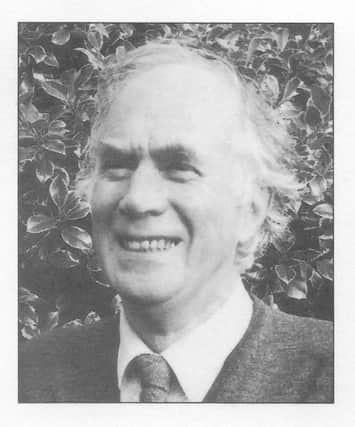Obituary: Iain MacIvor, Chief Inspector of Ancient Monuments for Scotland 1980-89


Iain MacIvor was born a Cumbrian but his roots were firmly on the other side of the Anglo-Scottish Border, for his father had served as station master at Riccarton Junction, on the old Waverley Line, prior to promotion to Carlisle Citadel.
In 1949 Iain went up to Durham University to read English. However, he soon fell under the spell of the charismatic master of his college, Eric Birley, the eminent Roman archaeologist. Iain was soon participating in excavations, notably at the Temple of Mithras at Carrawburgh, on Hadrian’s Wall, undertaken by Ian – later Sir Ian – Richmond and John Gillam in 1950. Iain achieved immortality through the photograph of him in the so-called ‘ordeal pit’ in the temple, published in the subsequent excavation report. Iain went on to direct excavations at the mithraeum at Rudchester, also on Hadrian’s Wall.
Advertisement
Hide AdAdvertisement
Hide AdIn 1955 Iain returned to his Scottish roots, following his appointment as assistant inspector of ancient monuments in the Edinburgh office of what was then the Ministry of Public Building of Works. There he took on responsibility for the Antonine Wall and in 1957 produced a report, which galvanised his office and its advisory body, the Ancient Monuments Board for Scotland, into action.
The core of his proposals and subsequent activities was the better protection of Imperial Rome’s north-west frontier. He achieved this through a programme of adding sections of the Wall to the list of protected sites, and by persuading the Ministry to take the best parts into state care. These included the major fort of Rough Castle, beside Falkirk, where he spent several summers excavating, creating a meaningful ancient monument for visitors and publishing the results of his work.
Meanwhile, Iain rose through the ranks of the Inspectorate, becoming a full inspector, principal inspector and finally chief inspector before retiring in 1989. Throughout these years, Iain tackled a series of difficult problems, and in all spheres set down the paths for his successors to follow. One major problem was the afforestation of large areas of upland Scotland.
Iain realised that not all archaeological sites could be saved and so created a framework for saving the best and excavating some of the others; the work he initiated at Rosal township, in Sutherland, was particularly important.
Iain also took a keen interest in the properties in state care, working closely with the architects on devising conservation programmes, writing guidebooks and persuading the Ministry to take additional monuments into care, most notably Craignethan Castle, near Lanark.
His organisational skills were certainly appreciated by the Ancient Monuments Board, whose tours he led over many years, while his junior colleagues benefitted from his knowledge and training.
All the while, Iain’s own interests were progressing from the Roman to the medieval and later periods. In 1964, following a major Army reorganisation, he was instrumental in initiating the restoration of Stirling Castle’s Great Hall, recently vacated by the Argyll & Sutherland Highlanders. He was also closely involved in major works at Edinburgh Castle, about which he wrote a book, and at the Palace of Holyroodhouse, where he investigated its rebuilding for Charles II. Iain’s tentacles even reached across the Anglo-Scottish frontier, serving as inspector for the fortifications at Berwick-upon-Tweed (until 1972 administered from Edinburgh), and writing the guidebook to them. And he didn’t stop there. Nineteenth-century prison architecture, such as Jedburgh and Perth, came under his scrutiny, and he derived a special pleasure from his work at Arnol Black House, in Lewis, built in the 1880s and taken into state care when the last residents left in 1964. His interests were truly eclectic, his research thorough. He had a brilliant mind.
Perhaps Iain’s greatest professional interest lay in military fortifications of the Jacobite era. When in 1964 the Seaforth & Cameron Highlanders marched out of Fort George, near Inverness, he rose to the challenge of taking the best-preserved 18th-century fortress in the British Isles into state care, researching its building history and presenting the property to the public. So absorbed was Iain in the subject of artillery fortification that he left his wife Marion and a friend in a café for several hours whilst he ‘inspected’ the fortified walls of Lucca, near Pisa!
Advertisement
Hide AdAdvertisement
Hide AdRetirement allowed Iain to return, physically and emotionally, to an earlier love – his native Border country. Marion and he forsook their home in India Street, in Edinburgh’s New Town – the birthplace of the eminent physicist James Clerk Maxwell, which they had lovingly restored to its original condition and generously passed on the James Clerk Maxwell Foundation – and settled in Smailholm village, close to Kelso. His final publication, A Fortified Frontier: Defences of the Anglo-Scottish Border, was published in 2001. He leaves behind Marion, his wife of almost 50 years, and step-daughter Diana.
DAVID BREEZE and CHRIS TABRAHAM